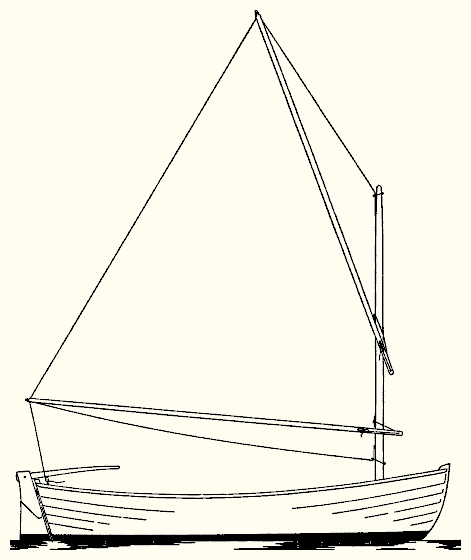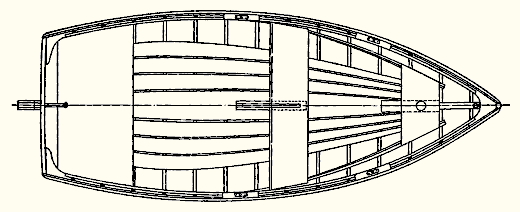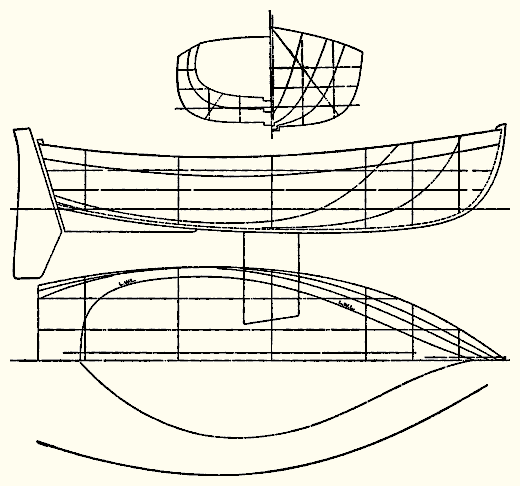
| Vintage A 10' Lapstrake Sailing Dinghy By William Atkin |
| A 10-Foot Lapstrake Dinghy | |
| Until the hurricane of 1938 I had a complete record of all the boat designs made to that date. For that period the record is now one from memory, and memory has a way of playing tricks. I thought I had nearly all the old designs in line, and knew each by name, if not by overall length and number. I therefore was surprised and pleased late in May to hear from Bill Koelbel, assistant editor of MoToR BoatinG, that he, in going over the magazine's many designs, had found one I had completely forgotten. This turned out to be No. 57, a 10-foot sailing dinghy, and the date it carries is October 10, 1919. While in storage the tracings became folded, torn and somewhat faded. However, after an hour's work we managed to unravel the ripped and crumpled paper and after ironing it flat and patching up with transparent scotch tape had essentials from which to work. In very, very faint lettering the signature on design No. 57 reads: Ten Foot Sailing Dinghy, for Captain Day. William Atkin, Arch., Montclair, N. J., Oct. 10, 1919. Design No. 57. | |

| |
Captain Day will be the late Thomas Fleming Day, founder and for many years editor of Rudder, but at that time proprietor of a marine store on Eighth Avenue, New York, selling boats, engines and other kindred merchandise. One of the walls of the store bore for its entire length a large painted message which read: "Give Up All Hope Ye Who Enter Here." For such was the atmosphere, charm and lure of the establishment that those that entered were likely to dig deeper into their pockets for this, that and the other thing than, when upon entering, they had interded. It was a fine store operated by an experienced and altogether delightful yachtsman. The dimensions of No. 57 are 10 feet over all; 8 feet 10 5/8 inches waterline; 3-feet 11 1/2 inches breadth; and 6 inches draft. The freeboard at the bow is, 1 foot 8 inches; at the lowest place, 1 foot 1 1/2 inches; and at the stern, 1 foot 5 inches. By these measurements one can see she is a burdensome little packet. Vintage, which is our name for the dinghy, is a round-bilge, lapstrake boat; she was designed in an era when most all round-bilge dinghies, and other small craft, were planked in that manner. It is of interest, and worth recording, that the wheel of time is again making popular small round-bilge, lapstrake motor and sailing boats. From keel to masthead, stem to stern, Vintage was designed precisely as suggested by Captain Day. He had in view a nicely balanced boat which would sail well, row easily and, at the same time, be in her element under the urge of an outboard motor; a small one, of course, because three decades and more ago there were no high-powered machines of this kind. If my memory is not at fault a considerable number of Captain Day's dinghies were built up in New York state by the Penn Yan Boat and Canoe Company, some of these put on display in his Eighth Avenue marine supply store. | |

| |
The designs of No. 57 were not published in MoToR BoatinG among the regular month-by-month contributions; I presume it must have been an extra, the circumstances of which have escaped me. However, there was a design of an 8-foot sailing dinghy similar in characteristics to Vintage published in the magazine, and at a later date in one of the volumes of the Ideal Series. The name of this little one is Handy Andy -- an identical sister, excepting only the overall length. Like the 10-footer, Handy-Andy proved to be unusually well behaved -- her breadth was half her length -- a very fat lady. The 10-footer was rigged with spritsail spreading 53 square feet of light canvas. The mast stood without standing rigging and it, with the boom and sprit, were light and short enough to stow inside the dinghy. A small sprit sail is a grand rig for just sailing around in a little boat; it needs no costly fittings, halyards and what-nots. It is simplicity itself; to reef just take in the sprit; to douse sail just take in the boom and muzzle the sail around the mast. These are all small light-weight spars and easily handled. Because the spars and sail can be quickly taken in and stowed in the dinghy it is an ideal sailing rig for a boat of this kind which is to be towed. It may not be amiss to add that the sprit sail rig exactly as designed herewith was specified by Captain Day. | |

| |
| As an afterthought I should mention that during the life of the marine store Captain Day camp-cruised under power of an outboard motor and sail in one of the Penn Yan dinghies from New Rochelle, N. Y., to, if I remember correctly, Newport, R. I. -- camping by night, sailing by day. Oldtime Shipmates, if I am in error here, correct me; memory often plays uncertain tricks. | |
 PHOTOS OF VINTAGE PHOTOS OF VINTAGE 
| |
| Plans for Vintage are $100 MYSTIC SEAPORT MUSEUM SHIPS PLANS STORE https://store.mysticseaport.org/ships-plans/ shipsplanstore@mysticseaport.org
+1 (860) 572 5360 | |
| BACK TO PLAN LIST | |